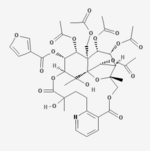Wilfortrine

|
| Identifiers
|
|
|
|
|
|
|
|
|
|
InChI=1S/C41H47NO20/c1-19(43)54-18-40-32(58-22(4)46)28(56-20(2)44)27-30(57-21(3)45)41(40)39(8,52)31(29(33(40)59-23(5)47)60-34(48)24-12-15-53-16-24)61-36(50)37(6,51)13-11-26-25(10-9-14-42-26)35(49)55-17-38(27,7)62-41/h9-10,12,14-16,27-33,51-52H,11,13,17-18H2,1-8H3/t27-,28-,29+,30-,31+,32-,33+,37?,38+,39?,40-,41+/m1/s1 Key: JOKOHWLSQAZHFX-FYBNDBPCSA-N
|
CC(=O)OC[C@]12[C@@H]([C@@H]([C@@H]3[C@H]([C@]14C([C@H]([C@@H]([C@@H]2OC(=O)C)OC(=O)C5=COC=C5)OC(=O)C(CCC6=C(C=CC=N6)C(=O)OC[C@@]3(O4)C)(C)O)(C)O)OC(=O)C)OC(=O)C)OC(=O)C
|
| Properties
|
|
|
C41H47NO20
|
| Molar mass
|
873.814 g·mol−1
|
Except where otherwise noted, data are given for materials in their standard state (at 25 °C [77 °F], 100 kPa). |
| Infobox references
|
|
|
|
Tracking categories (test):
Wilfortrine is a sesquiterpene alkaloid isolated from Tripterygium wilfordii.[1]
It has immunomodulatory effects.
References
- ↑ Zheng, YL; Xu, Y; Lin, JF (1989). "Immunosuppresive effects of wilfortrine and euonine". Yao Xue Xue Bao = Acta Pharmaceutica Sinica 24 (8): 568–72. PMID 2618700.


